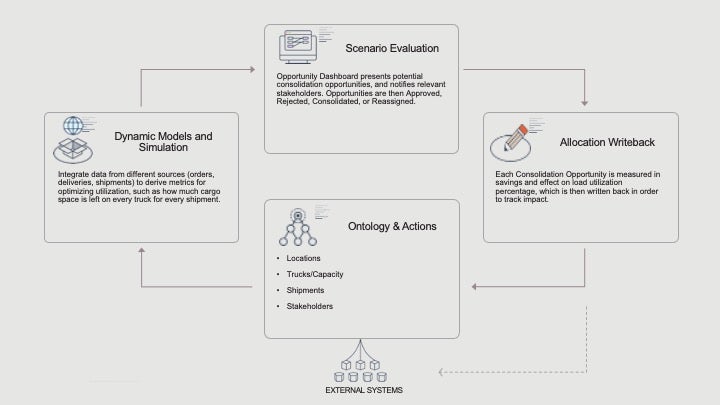Reducing the number of containers shipped by optimizing their utilization
Industry Sector: Consumer Products
Business Function: Logistics
A manufacturer pays for a full truck no matter how much of the truck is filled, so any empty truck space is a loss. The Load Utilization Tool surfaces opportunities for two or more shipments to be consolidated onto one truck, minimizing the empty space on trucks, and reducing costs. Opportunities are surfaced based on geographic proximity (for example, these two shipments are leaving from the same location, heading to two nearby locations, and would fit on one truck) and/or timing (for instance, these two trucks are each half full, making the same trip 12 hours apart).
Challenge
Historically, this process was managed via email and phone conversations. For example, a Load Planner needs to ship 5% of a truck from A to B. They send emails to other Load Planners and other Plants and Distribution Centers to find out if anyone has a truck that can hold an extra 5%, so they don't need to pay for a full truck. Many stakeholders need to get looped in, and if people don't respond, the user can't know what the optimal shipment to combine with would be, or if one even exists.
Solution
In Foundry, users can quickly find the latest information on shipments and fleet utilization. By integrating data from different sources (orders, deliveries, shipments), additional information can be derived, like how much cargo space is left on every truck for every shipment. Taking additional data like customer location into account, users can see all shipments with all related data in a single view. From here, they can easily take decisions on how to route and prioritize different shipments by comparing different scenarios.
A Load Planner reviews an Opportunity Dashboard for potential consolidation opportunities that include the shipments they are responsible for, and notifies the relevant stakeholders (plant, customer, carrier, etc.). These opportunities take into account extra stops, rescheduled pickup/delivery appointments, and plant/customer constraints. The Load Planner then Approves, Rejects, Consolidates, or Reassigns the Opportunity.

Impact
For each Consolidation Opportunity, we measure:
- Number of trucks "saved" or eliminated.
- Total savings (in freight cost).
- Mileage savings (future iterations can include CO2 emission reduction associated with mileage reduction).
- Increase in load utilization percentage (representing inventory volume/capacity).
Within 6 weeks, Foundry entirely replaced the existing system and process.
Implement a similar use case
This use case implements the following Pattern. Follow the link below to read more about a particular Pattern and learn how it is implemented within Foundry.
- Resource allocation & optimization (used for 3 other use cases)
Want more information on this use case? Looking to implement something similar? Get started with Palantir. ↗